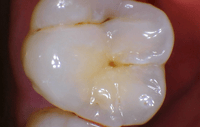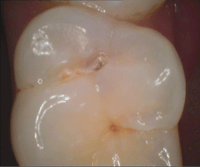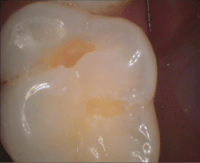By Martin Jablow DMD
According to a survey conducted in 2007 by the American Dental Association, half of all dental income relies on bonded procedures.
There are many steps in a direct bonded restoration procedure, and each one of them is critical to achieving a successful long term direct bonded restoration. Minimizing some of these steps without compromising quality dentistry can reduce the chance of a total bond failure or inadequate bond. I will discuss the steps and highlight potential areas to ensure direct bonded restoration success.
The first place to ensure success of any dental restoration starts with a correct diagnosis. You need adequate tooth structure to bond to along with being able to successfully isolate the tooth from moisture. This will allow you to start the procedure with the greatest chance for success.
In the following, I will walk you through a procedure I recently completed. After the patient was anesthetized a Dry Shield was placed to isolate the area from oral fluids and to allow for a stress free way to place a restoration, as it also allows the patient to have a bite block and keeps the tongue and cheek out of the way. Decay was diagnosed in the maxillary left first molar.
|
|
|
|
- An electric handpiece was used to expose and remove the decay. Electric handpieces produce less vibration and will reduce the chance of creating micro fractures in the tooth.
- Now we are ready to start the bonding procedure. The tooth is rinsed and lightly air dried. You do not want to desiccate the dentin. Tokuyama Universal Bond (Tokuyama Dental America) was chosen as it is a self-cured universal adhesive that bonds to all dental substrates without the need for additional primers or activators. Applied in three simple steps, (mix, apply and air dry), Tokuyama Universal Bond eliminates the need to light-cure, agitate the surface, use additional products or wait before placement of restorative. By removing multiple steps from the procedure, the time to start the placement of the restoration is shortened by as much as 60 seconds. This is where potential contamination of the preparation is reduced by the elimination of all the additional steps necessary with many bonding agents.
- Following the placement of the bonding agent, Estelite Bulk Fill Flow Shade A2 (Tokuyama Dental America) was expressed into the cavity preparation. This bulk fill composite was chosen because of its strength, good wear characteristics, low shrinkage and great polishability; and it flows easily into the preparation. No need for a foldable composite layer.
- For preparations less than 4mm in depth you can use this bulk fill directly as a one-layer fill. The composite was then light cured for 10 seconds. Do not overlook composite curing as a possible failure point, 30% of curing lights only deliver half the energy dose required by the material, according to a 2015 article from the International Association for Dental Research. This is an area of great concern in regard to the longevity of our restorations and possible patient sensitivity. Make sure your curing light tip is clean and read the directions for the materials so that you are sure of the proper curing times. You do not want to under cure the material or overheat a tooth.
- If the restoration depth exceeds 4mm then an additional bulk fill layer can be placed to complete the restoration, or you may consider using OMNICHROMA (Tokuyama Dental America) as the final layer for maximum esthetics. The occlusion was checked with articulating paper and any adjustments made. After the occlusion is deemed correct the restoration was polished.

- The patient was given postoperative instructions and dismissed.
Through the use of newer bonding agents and restorative materials the number of procedural steps and time for placement of a direct composite restoration has been reduced. This shortened procedure will help reduce the chance of operator errors and will help assure a successful direct bonded composite restoration.
Marty Jablow, DMD, is America's Dental technology Coach and is the president of Dental Tech Advisors and owner of The Dentists of Woodbridge located in Woodbridge, NJ. Dr. Jablow is a key opinion leader in dentistry. He has attained Fellowships in the Academy of General Dentistry and Academy of Dental Facial Aesthetics. Dr. Jablow has been recognized by Dentistry Today as one of the top lecturers in the country.



